Uses

Theories on the use of graffiti by avant-garde artists have a history dating back at least to the Asger Jorn, who in 1962 painting declared in a graffiti-like gesture "the avant-garde won't give up".
Many contemporary analysts and even art critics have begun to see artistic value in some graffiti and to recognize it as a form of public art. According to many art researchers, particularly in the Netherlands and in Los Angeles, that type of public art is, in fact an effective tool of social emancipation or, in the achievement of a political goal.
In times of conflict, such murals have offered a means of communication and self-expression for members of these socially, ethnically, or racially divided communities, and have proven themselves as effective tools in establishing dialog and thus, of addressing cleavages in the long run. The Berlin Wall was also extensively covered by graffiti reflecting social pressures relating to the oppressive Soviet rule over the GDR.
Many artists involved with graffiti are also concerned with the similar activity of stenciling. Essentially, this entails stenciling a print of one or more colors using spray-paint. Recognized while exhibiting and publishing several of her coloured stencils and paintings portraying the Sri Lankan Civil War and urban Britain in the early 2000s, graffitists Mathangi Arulpragasam, aka M.I.A., has also become known for integrating her imagery of political violence into her music videos for singles "Galang" and "Bucky Done Gun", and her cover art. Stickers of her artwork also often appear around places such as London in Brick Lane, stuck to lamp posts and street signs, she having become a muse for other graffitists and painters worldwide in cities including Seville.
Personal expression
Many graffitists choose to protect their identities and remain anonymous or to hinder prosecution.
With the commercialization of graffiti (and hip hop in general), in most cases, even with legally painted "graffiti" art, graffitists tend to choose anonymity. This may be attributed to various reasons or a combination of reasons. Graffiti still remains the one of four hip hop elements that is not considered "performance art" despite the image of the "singing and dancing star" that sells hip hop culture to the mainstream. Being a graphic form of art, it might also be said that many graffitists still fall in the category of the introverted archetypal artist.
Banksy is one of the world's most notorious and popular street artists who continues to remain faceless in today's society. He is known for his political, anti-war stencil art mainly in Bristol, England, but his work may be seen anywhere from Los Angeles to Palestine. In the UK, Banksy is the most recognizable icon for this cultural artistic movement and keeps his identity a secret to avoid arrest. Much of Banksy's artwork may be seen around the streets of London and surrounding suburbs, although he has painted pictures throughout the world, including the Middle East, where he has painted on Israel's controversial West Bank barrier with satirical images of life on the other side. One depicted a hole in the wall with an idyllic beach, while another shows a mountain landscape on the other side. A number of exhibitions also have taken place since 2000, and recent works of art have fetched vast sums of money. Banksy's art is a prime example of the classic controversy: vandalism vs. art. Art supporters endorse his work distributed in urban areas as pieces of art and some councils, such as Bristol and Islington, have officially protected them, while officials of other areas have deemed his work to be vandalism and have removed it.
Pixnit is another artist who chooses to keep her identity from the general public. Her work focuses on beauty and design aspects of graffiti as opposed to Banksy's anti-government shock value. Her paintings are often of flower designs above shops and stores in her local urban area of Cambridge, Massachusetts. Some store owners endorse her work and encourage others to do similar work as well. "One of the pieces was left up above Steve's Kitchen, because it looks pretty awesome"- Erin Scott, the manager of New England Comics in Allston, Massachusetts.citation needed
- Personal graffiti
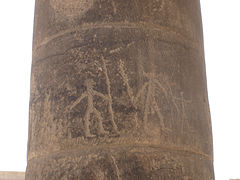
Drawing at Temple of Philae, Egypt depicting three men with rods, or staves.

Inscription in Pompeii lamenting a frustrated love, "Whoever loves, let him flourish, let him perish who knows not love, let him perish twice over whoever forbids love."

Post-apocalyptic despair
Mermaid in Sliema, Malta
Radical and political
Graffiti often has a reputation as part of a subculture that rebels against authority, although the considerations of the practitioners often diverge and can relate to a wide range of attitudes. It can express a political practice and can form just one tool in an array of resistance techniques. One early example includes the anarcho-punk band Crass, who conducted a campaign of stenciling anti-war, anarchist, feminist, and anti-consumerist messages throughout the London Underground system during the late 1970s and early 1980s. In Amsterdam graffiti was a major part of the punk scene. The city was covered with names such as "De Zoot", "Vendex", and "Dr Rat". To document the graffiti a punk magazine was started that was called Gallery Anus. So when hip hop came to Europe in the early 1980s there was already a vibrant graffiti culture.
The student protests and general strike of May 1968 saw Paris bedecked in revolutionary, anarchistic, and situationist slogans such as L'ennui est contre-révolutionnaire ("Boredom is counterrevolutionary") and Lisez moins, vivez plus ("Read less, live more"). While not exhaustive, the graffiti gave a sense of the 'millenarian' and rebellious spirit, tempered with a good deal of verbal wit, of the strikers.
The developments of graffiti art which took place in art galleries and colleges as well as "on the street" or "underground", contributed to the resurfacing in the 1990s of a far more overtly politicized art form in the subvertising, culture jamming, or tactical media movements. These movements or styles tend to classify the artists by their relationship to their social and economic contexts, since, in most countries, graffiti art remains illegal in many forms except when using non-permanent paint. Since the 1990s with the rise of Street Art, a growing number of artists are switching to non-permanent paints and non-traditional forms of painting.
Contemporary practitioners, accordingly, have varied and often conflicting practices. Some individuals, such as Alexander Brener, have used the medium to politicize other art forms, and have used the prison sentences enforced on them as a means of further protest. The practices of anonymous groups and individuals also vary widely, and practitioners by no means always agree with each other's practices. For example, the anti-capitalist art group the Space Hijackers did a piece in 2004 about the contradiction between the capitalistic elements of Banksy and his use of political imagery.
Territorial graffiti marks urban neighborhoods with tags and logos to differentiate certain groups from others. These images are meant to show outsiders a stern look at whose turf is whose. The subject matter of gang-related graffiti consists of cryptic symbols and initials strictly fashioned with unique calligraphies. Gang members use graffiti to designate membership throughout the gang, to differentiate rivals and associates and, most commonly, to mark borders which are both territorial and ideological.
- Political graffiti around the world

Anti Iraqi war graffiti by street artist Sony Montana in Cancun, Mexico (2007)
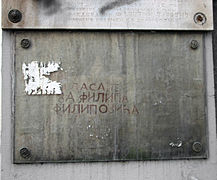
Wall in Belgrade, Serbia, with the slogan "Vote for Filip Filipović", who was the communist candidate for the mayor of Belgrade (1920)

An interpretation of Liberty Leading the People on the separation barrier which runs through Bethlehem

WWII bunker near Anhalter Bahnhof (Berlin) with a graffiti inscription Wer Bunker baut, wirft Bomben (those who build bunkers, throw bombs)

Graffiti on the train line leading to Central Station in Amsterdam
"Let's JOKK" in Tartu refers to political scandal with the Estonian Reform Party (2012)

Mural tribute to Cambodian revolutionary leader Pol Pot in Sundsvall, Sweden (2007)
Stencil in Pieksämäki representing former president of Finland, Urho Kekkonen, well known in Finnish popular culture

Feminist graffiti in A Coruña, Spain that reads "Enough with rosaries in our ovaries"

East Timorese protest against Australian petroleum extraction
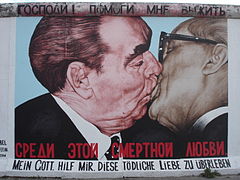
Graffiti of two communist leaders kissing, on the Berlin Wall
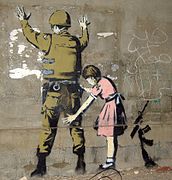
Ironic graffiti in Bethlehem

Berlin Wall: "Anyone who wants to keep the world as it is, does not want it to remain"
As advertising
This section does not cite any sources. (March 2009) (Learn how and when to remove this template message) |
Graffiti has been used as a means of advertising both legally and illegally. Bronx-based TATS CRU has made a name for themselves doing legal advertising campaigns for companies such as Coca-Cola, McDonald's, Toyota, and MTV. In the UK, Covent Garden's Boxfresh used stencil images of a Zapatista revolutionary in the hopes that cross referencing would promote their store.
Smirnoff hired artists to use reverse graffiti (the use of high pressure hoses to clean dirty surfaces to leave a clean image in the surrounding dirt) to increase awareness of their product.
- Advertising graffiti

Ancient Pompeiian graffiti advertising by a pimp

Graffiti as advertising in Haikou, Hainan Province, China, which is an extremely common form of graffiti seen throughout the country

Graffiti as legal advertising on a grocer's shop window in Warsaw, Poland
Offensive graffiti
Graffiti may also be used as an offensive expression. This form of graffiti may be difficult to identify, as it is mostly removed by the local authority (as councils which have adopted strategies of criminalization also strive to remove graffiti quickly). Therefore, existing racist graffiti is mostly more subtle and at first sight, not easily recognized as "racist". It can then be understood only if one knows the relevant "local code" (social, historical, political, temporal, and spatial), which is seen as heteroglot and thus a 'unique set of conditions' in a cultural context.
- A spatial code for example, could be that there is a certain youth group in an area that is engaging heavily in racist activities. So, for residents (knowing the local code), a graffiti containing only the name or abbreviation of this gang already is a racist expression, reminding the offended people of their gang activities. Also a graffiti is in most cases, the herald of more serious criminal activity to come. A person who does not know these gang activities would not be able to recognize the meaning of this graffiti. Also if a tag of this youth group or gang is placed on a building occupied by asylum seekers, for example, its racist character is even stronger.
By making the graffiti less explicit (as adapted to social and legal constraints), these drawings are less likely to be removed, but do not lose their threatening and offensive character.
Elsewhere, activists in Russia have used painted caricatures of local officials with their mouths as potholes, to show their anger about the poor state of the roads. In Manchester, England a graffitists painted obscene images around potholes, which often resulted in their being repaired within 48 hours.



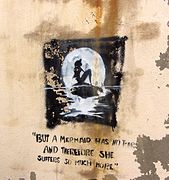
















Comments
Post a Comment